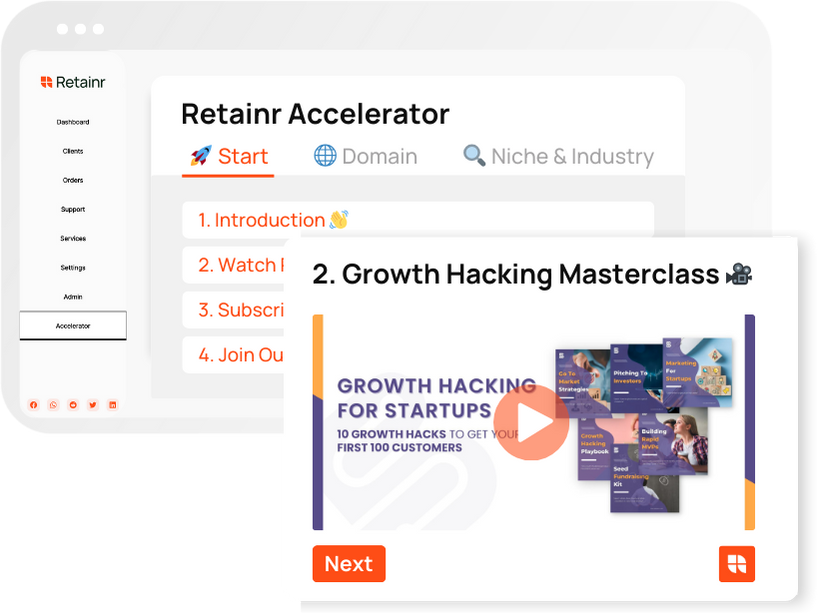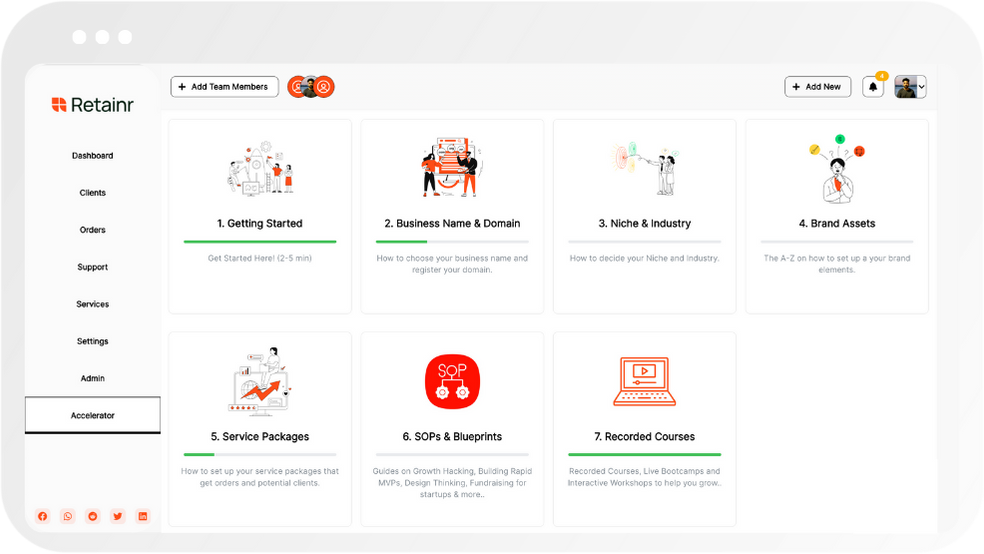
10 Best Practices for Agency Identity Management
Build with Retainr
Sell your products and services, manage clients, orders, payments, automate your client onboarding and management with your own branded web application.
Get Started1. What are the 10 best practices for agency identity management?
Implement a Robust Identity Verification Process
To ensure the security and integrity of your agency, a strong identity verification method needs to be in place. This allows you to verify a user's identity accurately before granting them access to your systems. This process might include two-factor authentication, bio-metric data, and security questions.
- Two-factor authentication: This method adds an extra layer of security by requiring users to provide two pieces of evidence to verify their identity.
- Biometric data: This includes items like fingerprints, facial recognition, and iris scans. While this method can provide a high degree of security, it needs careful handling due to privacy concerns.
- Security questions: This traditional method can be useful as part of a multifactor authentication strategy.
Maintaining an Access Control System
Having a secure access control system is crucial for managing different user identities in your agency. It involves constant monitoring and review of who has access to your systems and data. Regular updates and removal of inactive users are also of utmost importance.
| Role | Access Level |
|---|---|
| Admin | Full access to all systems |
| Standard user | Limited access based on role |
| Guest | Minimal access |
Ensure Regular Audits and Updates
A regular audit of your identity management systems will help you identify any loopholes or weaknesses. This provides an opportunity to take corrective actions and update your systems. This should also include regular user training to ensure they follow best practices.
- Carry out regular audits to identify and patch loopholes.
- Update systems regularly to incorporate the latest security measures.
- Provide user training to avoid security breaches due to human error.
2. Could you briefly explain the importance of each of these best practices?
Understanding the Importance of Best Practices
Identity management practices are crucial in agency operations and cannot be underestimated. Their importance cannot be overstated as they significantly influence an agency's ability to protect, manage, and control access to sensitive data and information. The following explains the significance of each practice:
- Single Sign-On (SSO): SSO allows users to log in once and gain access to all system resources, eliminating the need for multiple logins. This not only improves user experience but also enhances security by minimizing the possibility of password-related vulnerabilities.
- Multi-Factor Authentication (MFA): MFA requires users to provide two or more verification processes to access secure areas. This provides an additional layer of security, reducing the risk of unauthorized access.
- Least Privilege Access: This involves giving employees the minimum level of access needed to perform their tasks. This reduces the risk of insiders causing harm either accidentally or maliciously.
Importance of Regular Audits and Active Directory
Other practices also play a fundamental role in efficient and secure identity management:
- Regular Audits: Regular audits help identify any security gaps, unmanaged identities, or unnecessary privileges. It further helps in maintaining compliance with various regulations.
- Utilizing an Active Directory (AD): An Active Directory effectively manages user data, security, and distributed resources, and enables interoperation with other directories. This leads to a well-organized and secure identity management process.
Role of Biometrics and User Awareness Training
Lastly, our discussion would not be complete without these essential practices:
| Best Practices | Importance |
|---|---|
| Biometric Authentication: | Biometric authentication uses unique physical or biological traits of a person for identification. This makes it nearly impossible for unauthorized individuals to gain access. |
| User Awareness Training: | Even the best technologies cannot fully safeguard against human error. Training employees to be aware of security threats and how their actions can impact the agency's security significantly increases the organization's overall security posture. |
3. How can these best practices help mitigate the risk of identity theft or fraud within an agency?
The Role of Best Practices in Mitigating Risks.
Implementation of a robust set of best practices enhances an agency’s resilience against identity theft or fraud. They present safeguarding measures against cyber threats and all forms of unauthorized data access. These steps ensure maximum levels of security are upheld consistently.
- Regular audits: Agencies can maintain a healthy security posture by conducting regular audits. This process includes checking system vulnerabilities and fixing them, patching software and consistently reviewing the state of sensitive information.
- Multi-Factor Authentication (MFA): This security system requires more than one method of authentication from independent categories of credentials to validate a user's identity for login or other transactions. MFA can be vital in mitigating the risk of cyber theft as it minimizes the likelihood of unauthorized access.
- Employee Training: Cybercriminals often target unsuspecting employees via phishing emails and the likes. Therefore, equipping employees with necessary cybersecurity knowledge can act as the first line of defense against such ploys.
Contributing Factors of Data Misdemeanor.
The prevalence of identity theft and fraud mainly results from certain loopholes present in one's security infrastructure. Familiarizing oneself with these gaps can help set up preventive measures. A brief look at such points of failure can be insightful.
| Weak Point | Impact |
|---|---|
| Weak Passwords | Easy for cybercriminals to guess and gain unauthorized access |
| Outdated Software | Vulnerable to malware and other forms of cyberattack |
| Unsecured Networks | May lead to data leaks, making it easy for hackers to intercept sensitive data |
Value of Adherence.
Putting best practices into action are no good if they are not strictly adhered to. It's also critical to continually evolve these practices in response to the ever-changing cyber threat landscape. Following the mentioned practices will not only mitigate the risks associated with identity theft and fraud but will also instil a culture of security mindfulness within the agency. This culture will go a long way in protecting the agency's identity and overall operational integrity.
4. Are there specific protocols to follow when implementing these best practices?
Protocols to Follow when Implementing Best Practices
Adhering to certain protocols can greatly streamline the process of agency identity management and reduce potential security risks. The following are generally regarded as the best procedures to follow:
- Establish Identity Verification Systems: To ensure the integrity of your agency’s identity management system, you should verify the identities of all individuals within the network.
- Implement Two-factor Authentication: This adds an additional layer of security by requiring users to provide two forms of identification before gaining access to the network.
- Regularly Update Security Protocols: With cyber threats evolving rapidly, it is imperative to stay updated on the latest security best practices and incorporate these changes into your network.
Additionally, maintaining a strong and proactive security posture often involves ensuring that all employees are aware of the importance of these protocols and are adequately trained to comply with them.
Protocols Comparison Table
| Protocol | Description | Benefits |
|---|---|---|
| Identity Verification Systems | Confirming the identities of all individuals within the network. | Improves overall integrity and trust in the network. |
| Two-factor Authentication | Adding another layer of security requiring two forms of identification. | Offers higher level of security, making it difficult for unauthorized access. |
| Regularly Update Security Protocols | Staying updated with latest security best practices and incorporating changes. | Keeps the system secure against the latest types of cyber threats. |
5. What challenges might we encounter when applying these best practices and how do we handle them?
Challenges in Implementing Best Practices
Integrating best practices for agency identity management is not always a straightforward process. Usually, organizations experience hurdles along the way, which may include resistance to change, lack of sufficient resources, or technical difficulties in setting up the necessary systems. Understanding these challenges will create a clearer path to overcome them.
- Resistance to Change: Employees may resist the new identity management protocols, finding it cumbersome to adapt to the changes. To overcome this, it is important to conduct training sessions to demonstrate the importance and benefits of improved security. Change management strategies can also be used to minimize disruption and resistance.
- Lack of Sufficient Resources: Implementing sophisticated security measures often requires substantial financial and time investment. In such cases, organizations need to conduct thorough cost-benefit analysis, plan for budget and gradually implement the changes.
- Technical Difficulties: Organizations may also encounter technical problems when implementing these protocols. Success may require employing an experienced IT team and seeking help from consultants or experts in the field when necessary.
The Value of Planning Ahead
Foresight and preparation are key to fulfilling agency identity management best practices. Below is a simplified table illustrating a potential plan to handle these challenges. The table is divided into three sections- Issue, Potential Solution, and Expected Outcome.
| Issue | Potential Solution | Expected Outcome |
|---|---|---|
| Resistance to Change | Conduct training and initiate change management strategies | Adoption of new protocols, reduced resistance |
| Lack of Sufficient Resources | Cost-Benefit analysis and budget planning | Organizational readiness for sufficient investment |
| Technical Difficulties | Hiring experienced IT team, consulting experts | Smooth implementation, early detection and resolution of technical issues |
The Importance of Flexible Strategies
While anticipated challenges may warrant preemptive action, unexpected issues could still arise. Hence, a flexible strategy will allow businesses to adapt accordingly. This includes being responsive to feedback from employees and being willing to adjust timelines. It's also necessary to stay updated with emerging trends in identity management and modify existing practices to ensure that an agency's management remains effective and secure.
6. How frequently should these practices be evaluated and updated?
Frequency of Evaluation and Update
Regular evaluation and updating of identity management practices is crucial to maintain the effectiveness and resilience against evolving security threats. The frequency of these evaluations and updates can highly depend on several factors, but there are industry standard cadences that are recommended as best practice.
- Quarterly: Every three months, agencies should conduct an internal audit of their identity management practices. This includes reviewing the overall system, checking adherence to existing protocols, assessing staff knowledge and awareness, and identifying any areas of improvement. This frequent check ensures your agency stays on top of any emerging threats and developments in the sector.
- Annually: On an annual basis, it's advisable to engage an external auditor for an in-depth, unbiased assessment. This should look at all elements covered in the quarterly reviews, as well as any changes in policy or legal requirements, new technology implementations, and any issues or breaches that occurred in the past year.
- As Needed: Specific events, such as policy changes, security breaches, technological updates or reshuffling of roles within the agency, may necessitate immediate evaluation and updating of identity management practices. This ensures that the system stays relevant and effective in real-time.
The table below gives a visual summary of the frequency at which various identity management practices should be evaluated and updated.
| Assessment Level | Frequency |
|---|---|
| Internal Review | Quarterly |
| External Audit | Annually |
| Event-Driven Assessment | As Needed |
It's important to remember that these are just guidelines and the specific context of your agency may dictate a different frequency. Always keep up-to-date with best practices in the field, ensure your staff are well trained on these procedures, and act swiftly in the face of new threats to avoid any compromise in your agency's identity management.
7. How do these best practices align with international standards for identity management?
Alignment with International Standards
Agency Identity Management best practices typically align with international standards in several ways. The goal of these standards is to ensure the efficiency, security, and interoperability of identity management systems across various geographical boundaries.
- The best practices embrace the principles of the International Organization for Standardization (ISO) for Identity Management. These principles include consent, minimal disclosure for a constrained use, justified party, transparency, and respect for user privacy, among others.
- They apply the General Data Protection Regulation (GDPR) scaffolding where essential, promoting data privacy by giving individuals control over their personal data and simplifying the regulatory environment for international business.
- The best practices also take into account the principles set forth by the National Institute of Standards and Technology (NIST) for Digital Identity Guidelines, notably, the risk-based approach in identity proofing and authentication of users.
ISO Standards and Agency Identity Management
The best practices revolve around creating and managing identities that are not only secure but also user-friendly. The table below outlines how some of these practices align with ISO standards.
| Best Practices | ISO Standard |
|---|---|
| Using biometrics for authentication | ISO/IEC 24745: Biometric information protection |
| Auditing and monitoring identity management | ISO/IEC 27001: Information security management |
| Ensuring identity data integrity | ISO/IEC 29100: Privacy framework |
Adherence to GDPR and NIST Guidelines
Respecting user privacy while maintaining data integrity is paramount in identity management. Key practices that align with GDPR and NIST guidelines are:
- Using encryption methods to protect sensitive data: This adheres to the GDPR principle of 'data protection through design and by default' and to the NIST guidelines on cryptographic standards.
- Implementing Multi-Factor Authentication (MFA): By adding an extra layer of security, MFA aligns with NIST guidelines on digital identity assurance.
- Allowing data portability and supporting user rights over their data: This approach aligns with the GDPR's data subject rights provisions.
8. What resources or tools might be necessary to successfully implement these best practices?
Agency Identity Management Tools
To implement identity management best practices in any agency, a couple of resourceful tools are necessary. This includes but is not limited to:
- Identity and Access Management (IAM) Systems: These tools enable agencies to control access within their systems, thereby ensuring only authorized individuals have access to relevant resources.
- Multi-factor Authentication (MFA) Tools: These tools require users to provide two or more types of identification before access is granted, which augments security significantly.
- Single Sign-On (SSO) Tools: These help minimize the need for multiple credentials on various applications, consequently simplifying management and reducing the possibilities of security breaches.
These tools and resources are necessary to effectively manage agencies' identities, ensure security, and aid compliance to regulatory standards.
Implementation Resources
Aside from the core tools, other resources play an instrumental role in the successful implementation of Identity Management practices. They include:
| Resource | Description |
|---|---|
| Technical Personnel | A team of skilled IT professionals is crucial in handling software installation, system management, and incident response. |
| Training Programs | Regular training and awareness programs for non-IT staff help maintain appropriate practices and prevent potential security threats. |
| Security Policies | Clearly defined and documenτed security policies guide users on their access limits, responsibilities, and expected behaviours. |
Collectively, with the right set of tools and the necessary resources, any agency can effectively implement best practices for identity management, ensuring system security, and data protection.
9. How can these practices contribute to the overall efficiency and security of the agency?
Contribution to Overall Efficiency
These best practices for agency identity management significantly contribute to the overall efficiency of an agency. Firstly, by streamlining access management, the process of identity authentication is expedited, resulting in saved time and resources. Secondly, automated workflows allow for swift processing of tasks, reducing manual labor and related errors. Last but not least, with comprehensive audit trails, agencies can easily track all identity-related activities, saving time in investigations and reporting.
| Practice | Impact on Efficiency |
|---|---|
| Streamlined Access Management | Expedited process of identity authentication, saving time and resources. |
| Automated Workflows | Swift processing of tasks, reduced manual labor and associated errors. |
| Comprehensive Audit Trails | Easy tracking of all identity-related activities, saving time in investigations and reporting. |
Contribution to Overall Security
Agency identity management best practices also contribute to the overall security of an agency. To begin with, rigorous identity verification mechanisms reduce the risk of unauthorized access. Additionally, the application of role-based access control maintains agency security by ensuring that employees have access only to the information they need. Finally, regular security assessments and updates help to identify potential vulnerabilities and address them before they can be exploited.
| Practice | Impact on Security |
|---|---|
| Rigorous Identity Verification | Reduced risk of unauthorized access. |
| Role-Based Access Control | Maintains security by ensuring employees have access only to necessary information. |
| Regular Security Assessments and Updates | Identification and mitigation of potential vulnerabilities before exploitation. |
10. Can you give some examples of successful application of these best practices in identity management?
Examples of Successful Identity Management Practice
The domain of identity management is cluttered with numerous success stories detailing the commendable application of best practices. Among these, certain examples stand out, which demonstrate how a well-executed identity management strategy can greatly optimize a company's operations.
- Google effectively utilizes two-factor authentication, a form of identity verification, to ensure the right users are accessing their accounts. This has significantly reduced instances of account hijacking, ensuring a secure experience for users.
- Facebook has implemented continuous monitoring and real-time analytics to detect any unusual activity. This proactive approach has helped the social media giant in detecting and preventing security breaches.
- Amazon not only uses multi-factor authentication but also leverages AI algorithms to analyze user behavior, thereby identifying potential fraud incidents. The implementation of privacy by design, another identity management best practice, makes the customer's data more secure.
Comparison of Identity Management Approaches
In comparing these leading companies' identity management approaches, certain variances in practice and execution become evident. A tabulated format of comparison for the above-mentioned examples are provided below.
| Company | Main Identity Management Practice | Benefits |
|---|---|---|
| Two-factor Authentication | Decrease in account hijacking incidents | |
| Monitoring & Real-time Analytics | Proactive detection and prevention of security breaches | |
| Amazon | AI algorithms & Privacy by Design | Secure customer data and early detection of fraud incidents |
Incorporating Best Practices
All corporations, regardless of their size, can gain a lot by implementing these best practices in their strategies. The mentioned companies have greatly benefited from their effective identity management strategies, offering a great blueprint for other organizations to emulate.
Conclusion
Your Agency's Identity Management: Top 10 Best Practices
The importance of sound identity management as an agency is unrivaled. Not only does it foster smoother operations, but also fortify security and improve user experiences. Achieving effective identity management, however, demands adherence to certain best practices. Let's look at the top ten crucial ones:
Consolidating Identity Sources
Agencies should establish a unified access point to consolidate different identity sources. This improves control and monitoring of access privileges.
Implementing Multi-Factor Authentication
Multi-Factor Authentication (MFA) provides additional security layers, significantly reducing incidents of unauthorized access.
Regular Review and Revocation of Access Privileges
Periodic audits and reviews help eliminate unnecessary or outdated access privileges, reducing security vulnerabilities.
Systematic Onboarding and Offboarding Processes
Defined processes for adding or removing users ensure minimal disruption and maintain system integrity.
Continuous Training and Awareness
Regular training sessions and awareness programs can keep all stakeholders informed about the importance of security measures and best practices.
Monitoring and Reporting
Continuous activity monitoring and reporting help detect potential security breaching attempts and ensure compliance.
Risk Management
Identifying, assessing, and mitigating risks should be an ongoing process to improve system security.
Data Privacy Regulations Compliance
Agencies must ensure compliance with all relevant data privacy laws to avoid legal issues and potential damage to their reputation.
Adoption of Automation
Automation can streamline identity management tasks, reduce manual errors and increase productivity.
Choosing the Right Identity Management Tools
The right identity management software can make the above practices easier to implement and maintain. And here's where Retainr.io comes into play.
As a whitelabel software, Retainr.io enables agencies to sell, manage clients, orders, and payments with their own branded app. The platform equips agencies with the necessary tools to oversee access, manage user identities, and ensure optimal security. With Retainr.io, you can put these best practices into action, enhance your agency's security, and offer top-notch service to your clients.
Unlock the full potential of your agency's identity management with Retainr.io. Discover more today!
Boost Your Agency Growth
with Retainr Accelerator
Uncover secrets, strategies, and exclusive blueprints to take your agency's growth to the next level — from marketing insights to effective presentations and leveraging technology.

SOPs, Cheatsheets & Blueprints
Leverage 50+ SOPs (valued over $10K) offering practical guides, scripts, tools, hacks, templates, and cheat sheets to fast-track your startup's growth.
Connect with fellow entrepreneurs, share experiences, and get expert insights within our exclusive Facebook community.
.jpg)

Join a thriving community of growth hackers. Network, collaborate, and learn from like-minded entrepreneurs on a lifelong journey to success.

Gain expertise with recorded Courses, Live Bootcamps and interactive Workshops on topics like growth hacking, copywriting, no-code funnel building, performance marketing and more, taught by seasoned coaches & industry experts.

.jpg)

.jpeg)


